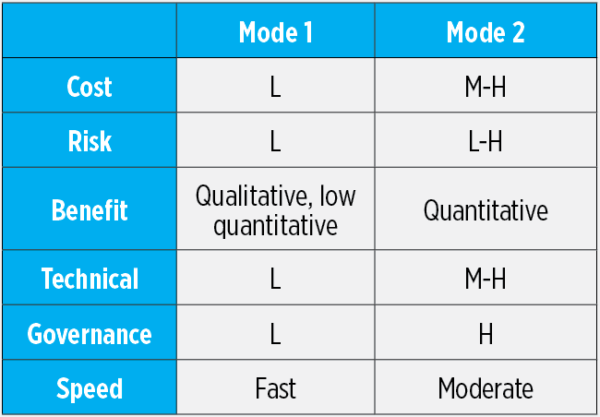Want to Make your Robotics Strategy Sustainable?

What is bi-modal RPA?
Bi-modal RPA is where an organization builds the internal skillsets, governance structure, and change management approaches to create two parallel tracks of RPA development. On one track, subject matter experts are embedded into business functions to identify and vet small ROI automation opportunities and build and implement less-technical automations internally. On the second track is an ROI-focused RPA approach, which focuses on identifying the biggest opportunities in the business, creates investment plans for them, and engages the right partners to build and execute these automations.
Why do we need it?
One of the most significant lessons learned, as RPA technologies have gained a foothold in corporate America, is that the most successful organizations don”™t just operationalize bots ”” they operationalize their entire approach to robotics. It isn”™t just about building and implementing the bots, it”™s about how companies increase the scope, reach, and depth of their automated processes over time.
In the beginning of RPA”™s existence, the goal was to automate end-to-end business processes ”” the entire recruit to hire process, or the entire order-to-cash process. This created large, expensive, and lengthy robotics projects that demanded both large software purchases and, more problematically, large consulting engagements. Over time, many businesses did not have the internal knowledge or structure to extend the leverage of their RPA tools.
To respond to this fundamental challenge and make RPA more realistic and faster to achieve value, we developed a bi-modal RPA approach. This approach was designed to minimize up-front risk, create the talent internally to work on small automations and perform the early stages of process evaluation and design, and move into an agile approach where bot enhancements (and in some cases new bots) can be constantly rolled out to the business.
How does it work?
At the beginning of your journey, you will need help. We start with a Rapid Automation Assessment, which takes two to four weeks and identifies between three and five relatively low-risk, high-reward automation opportunities which can be executed quickly. The goal is to have three to five automations live within 90 days.
During this project, we embed business subject matter experts into the team so they learn how to vet, design, and implement automations. These resources will be the champions in the business going forward. We also identify and support their certification processes of the RPA software.
As a result, you will have a governance structure in place and selected automation processes identified for new automations going forward. The identified automations will be assigned to one of the following modes:

Mode 1: User-driven, lightly governed
The goal of Mode 1 is to give the business functions control over automating processes or tasks that simplify and/or accelerate their daily activities.
The automations identified, built, and implemented in Mode 1 will be simpler, lower-risk, and less technical. Ideally, they should not require technical knowledge or outside services to build.
To encourage user adoption, these should be lightly governed, and have oversight largely within each function. We generally discourage putting hard ROI goals around the automations in this category ”” the ROI is not the point. The goal of these automations is to introduce robotics to the business and begin to increase automation regularly as your staff becomes skilled at using automation to do their jobs better and faster. Tracking ROI does not help achieve the transition to automation, but putting the focus on constantly improving and extending RPA capabilities does.
Mode 2: Management-driven, heavily governed
The goal of Mode 2 is to pursue ambitious ROI targets in large parts of the business. End-to-end processes, difficult to execute processes, and processes with complex technical requirements or interdependencies should utilize this structure.
These automations will have hard ROI targets, and these targets will include the cost required to provision the software necessary to build them. Because they carry a higher-risk profile, and because they require capital spending, we recommend these automations be governed by an RPA steering committee within the company. There should be process due diligence, organizational due diligence, and a benefits analysis prior to providing approval to begin the build.
Mode 2 automations will, and should, require expertise and development scale that is impractical for most companies to keep on hand. Your trusted RPA consultant should assist with vetting and building the automations alongside your team, and then operationalizing them with you. These automations may need ongoing monitoring and maintenance which should a) be included in the initial business case; and b) may be insourced or outsourced depending on your organization”™s needs. Either way, these automations should return significant ROI and, in general, be paid back quickly.
Our Rapid Automation Assessment takes two to four weeks. You will be provided with a plan, which includes a full software budget, a consulting budget, hours requirements, preliminary designs for three to five automations, and a tactical roadmap to roll out these automations, within 90 days.
From there, we can build the governance model, identify the key influencers for your RPA environment going forward, and get the right people certified on the toolset. We will help set up this capability and show you how to take full ownership of the solution set internally.
Carlos A. Catalan is a director and key player within Citrin Cooperman”™s Strategy & Business Transformation Practice. He is leading the Robotic Process Automation and Finance Transformation service lines for Citrin Cooperman. He is an experienced professional in the field of finance and execution while focusing on areas of finance acceleration, financial reporting, and automation. Carlos can be reached at ccatalan@citrincooperman.com.
Citrin Cooperman is a full-service accounting and advisory firm with 17 domestic and international locations. Visit us at citrincooperman.com.